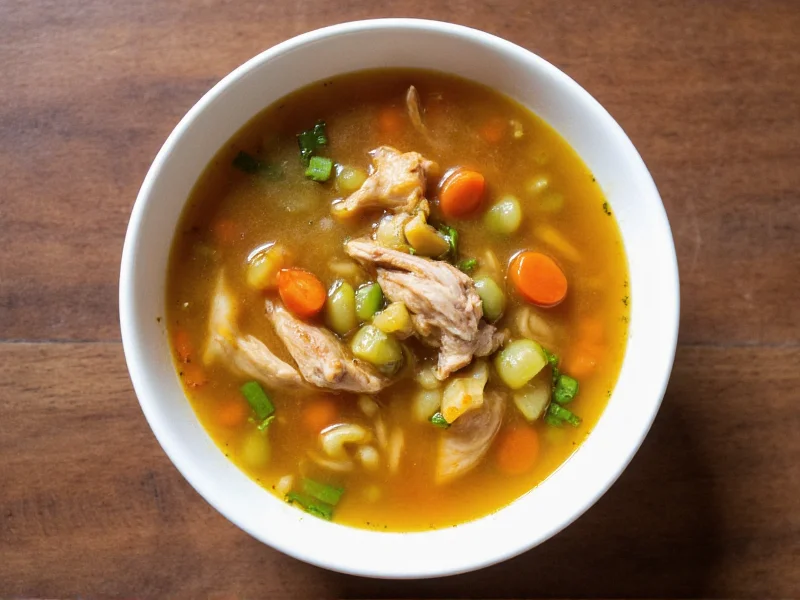For generations, traditional chicken soup has served as culinary comfort across continents. Unlike quick store-bought versions, authentic preparation requires patience and attention to detail. The magic happens when collagen from bones transforms into gelatin during slow simmering, creating that signature rich mouthfeel and cloudy appearance that signals proper technique.
The Cultural Tapestry of Chicken Soup
From Jewish penicillin to Chinese medicinal broths, traditional chicken soup appears in nearly every culture's culinary repertoire. Eastern European krupnik features barley and root vegetables, while Chinese versions often include ginger and goji berries for balancing qi. Latin American sopa de pollo incorporates cilantro and lime, and Greek avgolemono finishes with egg and lemon for tangy richness. Despite regional variations, the core principle remains consistent: slow extraction of nutrients and flavor from quality ingredients.
Essential Ingredients for Authentic Flavor
Creating genuine traditional chicken soup requires specific components that work synergistically:
| Ingredient Category | Key Components | Purpose |
|---|---|---|
| Chicken Base | Bones with marrow, meaty joints, carcass | Provides collagen, flavor depth, and body |
| Aromatic Vegetables | Onion, carrot, celery (mirepoix) | Creates flavor foundation without overpowering |
| Herbs & Seasonings | Parsley stems, thyme, bay leaf, black peppercorns | Adds complexity and aromatic notes |
| Acid Component | Vinegar or wine (small amount) | Helps extract minerals from bones |
Step-by-Step Traditional Preparation
Authentic homemade traditional chicken soup requires following time-tested techniques:
- Prepare the base: Place 2-3 pounds of chicken bones (with some meat attached) in a large stockpot. Cover with 3 quarts cold water. Add 2 tablespoons apple cider vinegar to help extract minerals.
- Initial simmer: Bring to gentle simmer (not boil) over medium heat. Skim foam that rises during first 20 minutes using a fine mesh skimmer.
- Add aromatics: After skimming, add 1 chopped onion, 2 chopped carrots, 2 chopped celery stalks, 4 parsley stems, 2 thyme sprigs, 1 bay leaf, and 10 black peppercorns.
- Slow cooking: Reduce heat to low, partially cover, and simmer gently for 3-4 hours. Never let the broth come to a full boil, which makes it cloudy.
- Strain and clarify: Carefully strain through a fine-mesh sieve lined with cheesecloth. Discard solids.
- Final seasoning: Return clear broth to clean pot. Add salt to taste and additional cooked chicken meat if desired. Simmer 10 minutes more.
Common Mistakes That Compromise Authenticity
Many home cooks unintentionally sabotage their traditional chicken soup preparation:
- Boiling instead of simmering: Vigorous boiling emulsifies fat into the broth, creating cloudiness and greasy texture
- Skipping the skimming step: Initial foam contains impurities that affect flavor if not removed
- Overloading with vegetables: Too many vegetables creates competing flavors rather than supporting the chicken essence
- Adding salt too early: Concentrates as liquid reduces, leading to oversalted final product
- Using only breast meat: Boneless, skinless breasts lack the collagen needed for proper body and flavor
Why Traditional Preparation Matters
Modern shortcuts often sacrifice the very qualities that make traditional chicken soup special. Instant pots and pressure cookers extract flavor quickly but miss the nuanced development that occurs during slow simmering. The extended cooking time allows for complete collagen conversion to gelatin, which provides the characteristic silky texture and potential digestive benefits. Properly made traditional chicken soup should congeal slightly when chilled—a sign of adequate gelatin extraction that commercial versions rarely achieve.
Storage and Reheating Best Practices
To maintain quality of your homemade traditional chicken soup:
- Cool broth rapidly by placing pot in ice water bath before refrigerating
- Store in airtight containers for up to 5 days in refrigerator
- Freeze in portion-sized containers for up to 6 months
- When reheating, bring to gentle simmer but avoid boiling to preserve texture
- Skim any fat that rises to surface during reheating for cleaner flavor
Traditional Chicken Soup Variations by Region
Different cultures have developed distinctive approaches to traditional chicken soup preparation:
- Eastern European: Often includes barley, dill, and egg noodles; served with sour cream
- Middle Eastern: Features turmeric, cilantro, and lemon; sometimes includes rice or orzo
- Asian: Typically includes ginger, garlic, and scallions; may incorporate mushrooms or seaweed
- Mediterranean: Uses olive oil, lemon, and fresh herbs; often includes rice or small pasta
- Mexican: Incorporates epazote, avocado, and lime; frequently served with tortilla strips
Frequently Asked Questions
How long should traditional chicken soup simmer for optimal flavor?
Traditional chicken soup requires 3-4 hours of gentle simmering to fully extract collagen from bones and develop complex flavors. Shorter times yield weaker broth, while excessive cooking can create bitter notes from over-extracted minerals.
Why does my traditional chicken soup turn cloudy?
Cloudiness typically results from boiling instead of simmering, which emulsifies fat into the broth. Not skimming the initial foam or adding vegetables too early can also contribute. For crystal-clear broth, maintain a gentle simmer and skim impurities during the first 20 minutes.
Can I make traditional chicken soup without meat on the bones?
While possible, traditional chicken soup benefits significantly from some meat attached to bones. The meat contributes flavor compounds during cooking, and you can remove it after simmering to add back as shredded chicken. Pure bone broth lacks the depth that meat provides to authentic traditional chicken soup.
What makes traditional chicken soup different from regular chicken broth?
Traditional chicken soup includes both the broth and solid components like vegetables and chicken meat, while broth refers specifically to the liquid. Authentic traditional chicken soup has a richer texture from gelatin extraction and balanced seasoning that makes it a complete dish rather than just a cooking ingredient.
How can I enhance the nutritional value of traditional chicken soup?
To maximize nutritional benefits, use organic chicken bones, include a small amount of vinegar to extract minerals, add a variety of colorful vegetables for phytonutrients, and avoid overcooking delicate greens. The slow simmering process naturally concentrates nutrients from bones and vegetables into an easily digestible form.











 浙公网安备
33010002000092号
浙公网安备
33010002000092号 浙B2-20120091-4
浙B2-20120091-4